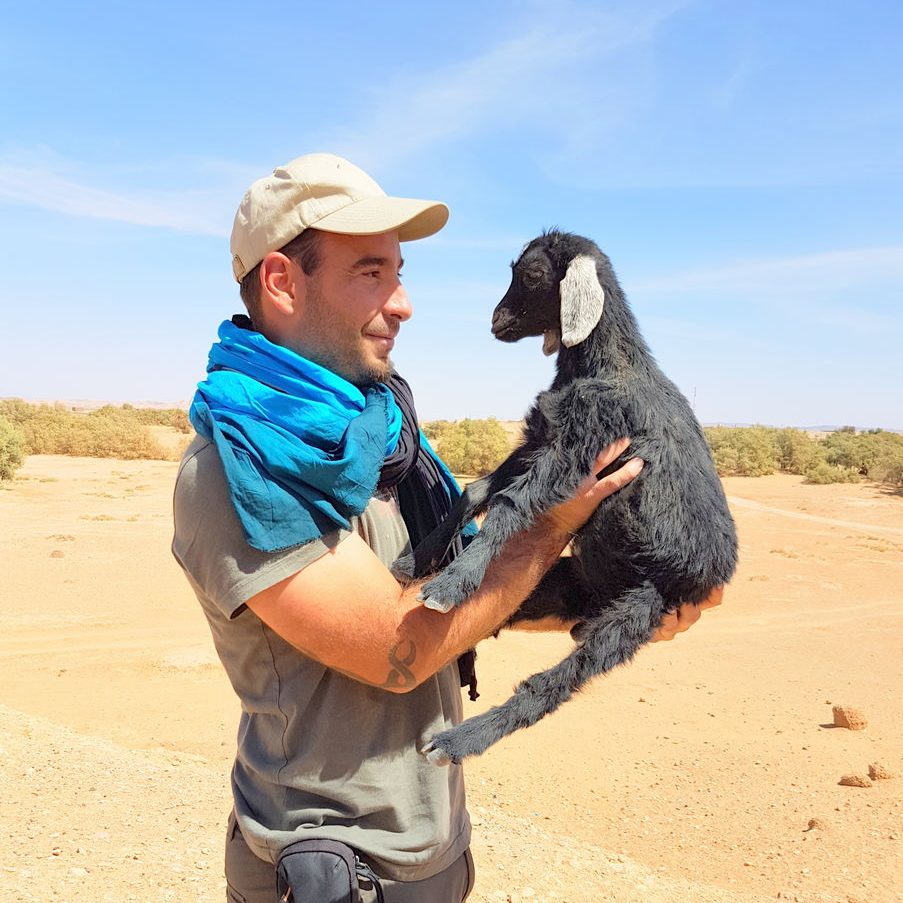Table of Contents
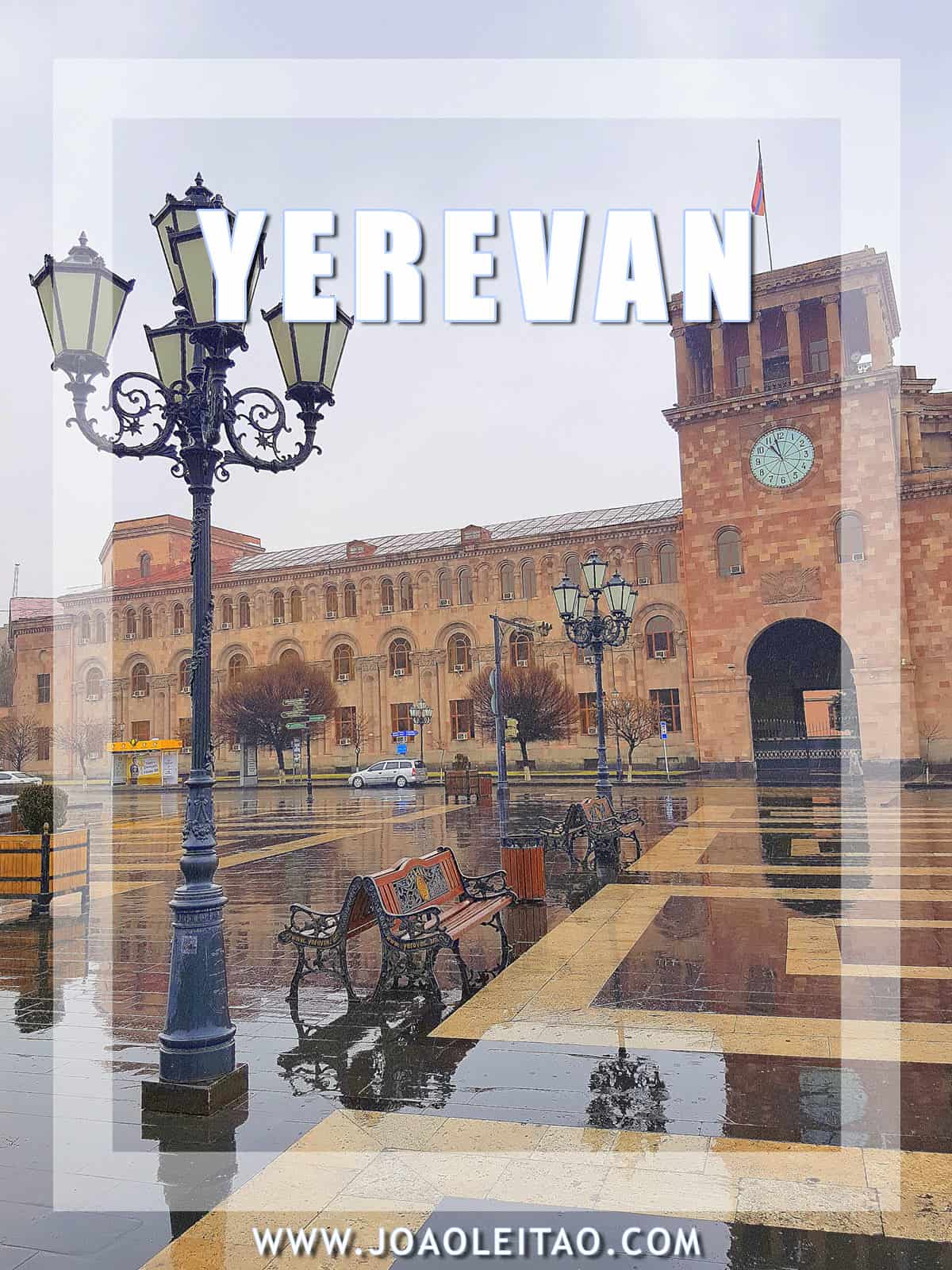
Yerevan is the capital of Armenia, offering the visitor an excellent base to explore the country and some points of interest that can be explored in a safe environment.
On this Yerevan City Guide, I will focus on the most important monuments and attractions to visit Yerevan in one or two days. Yerevan it’s a pleasant city that reflects the true nature of the Armenians, and with always-present Mount Ararat dominating the landscape.
The history of Yerevan dates back to the 8th century BC when a fortress was built, and which can be visited during your stay. Throughout the ages, Yerevan was conquered by multiple invaders: Persians, Arabs, Ottomans, and Russians.
Although the historic center of Yerevan was destroyed in the first half of the twentieth century to give way to a new city with monumental buildings and ample spaces, the city has a very unique charm.
Curiosities about Yerevan:
- Yerevan it’s home to over a million people;
- Yerevan is one of the world’s oldest continuously inhabited cities;
- Erebuni fortress in Yerevan is at least 2800 years old;
- Yerevan has an average height of 990 m (3,248 ft);
- Yerevan has long hot summers and cold winters;
- Yerevan is located at the northeast of the Ararat plain;
- The Yerevan TV Tower is the tallest building in the city;
- Yerevan is between the top 10 safest cities in the world;
- The Mother Armenia replaced a monumental statue of Joseph Stalin.
The symbolic universe of the Soviet Union can still be felt, and visitors will have much to be entertained. Strolling through the streets of the city and its most important squares will leave a mark on your memory, and there are numerous museums of which I will point out only the most important ones.
About one million people live in the Armenian capital, and you can experience the hospitality and friendliness of the inhabitants of Yerevan, roaming the residential areas and their very private courtyards that function as centers for the community that surrounds them.
Yerevan Top 5
Republic Square
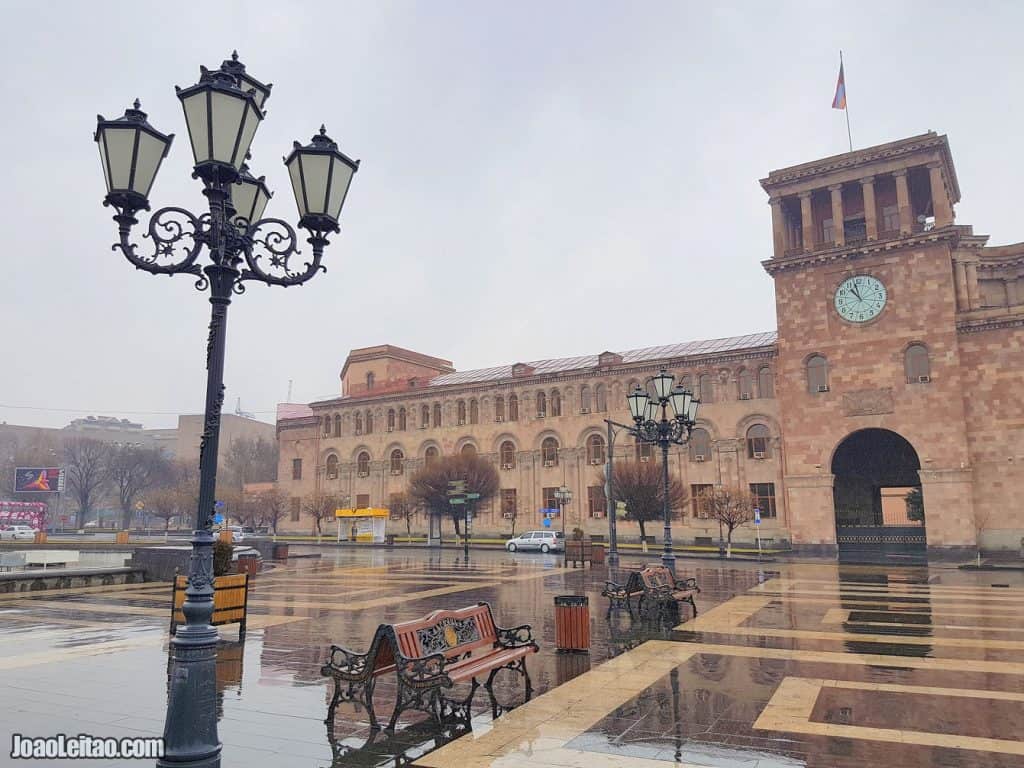
National Gallery of Armenia
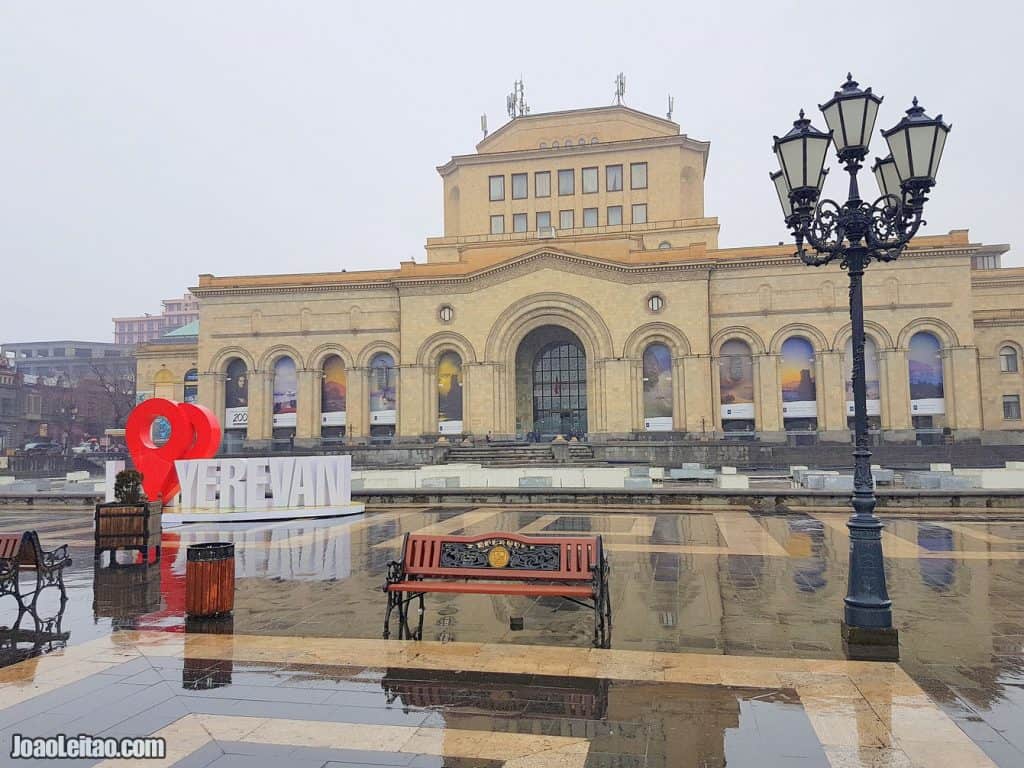
Fortress of Erebuni
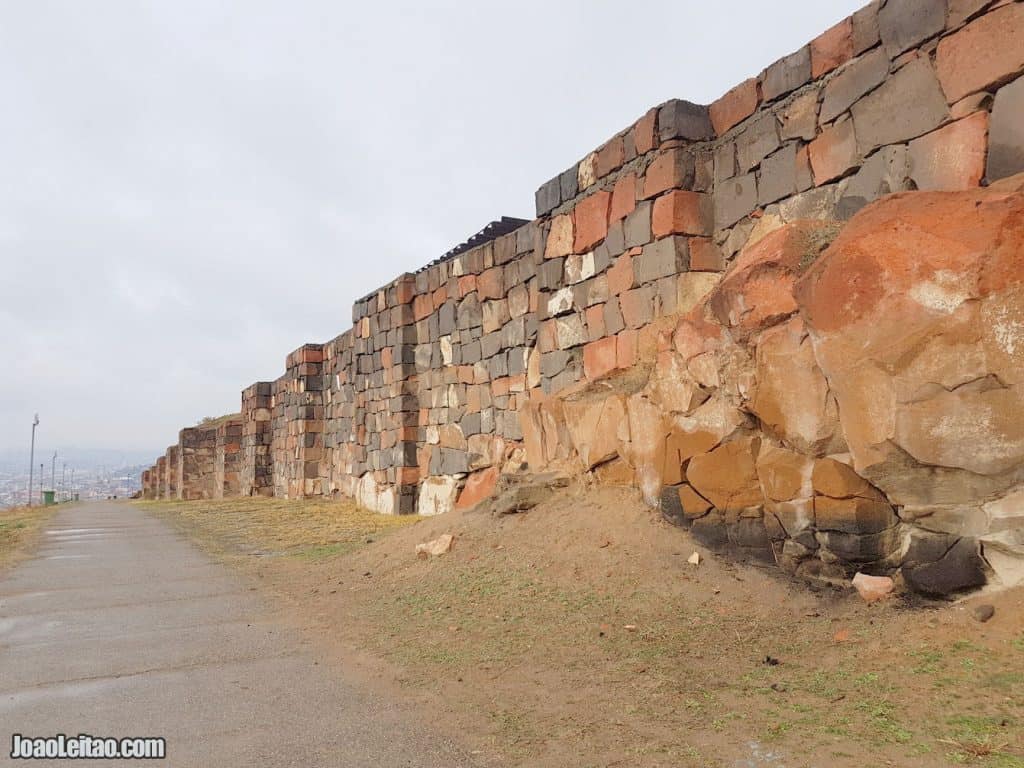
Yerevan Cascade
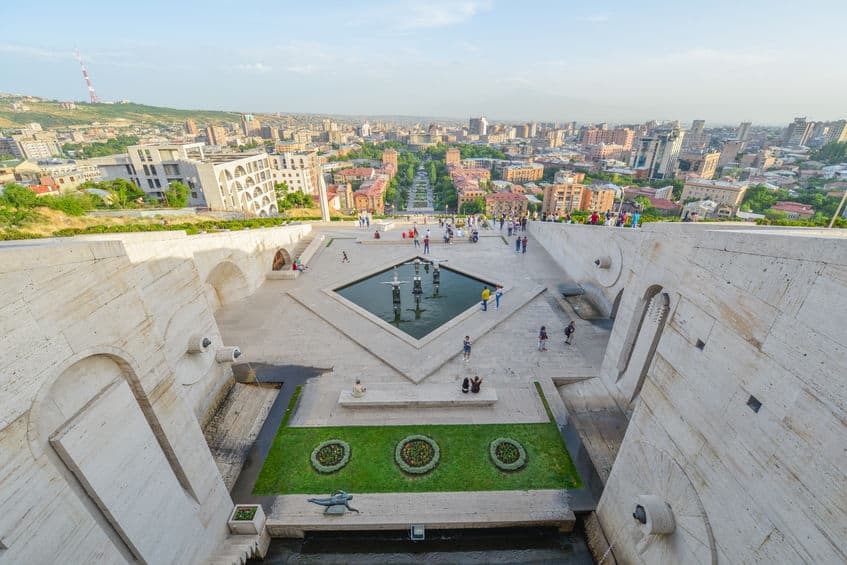
Katoghike Church
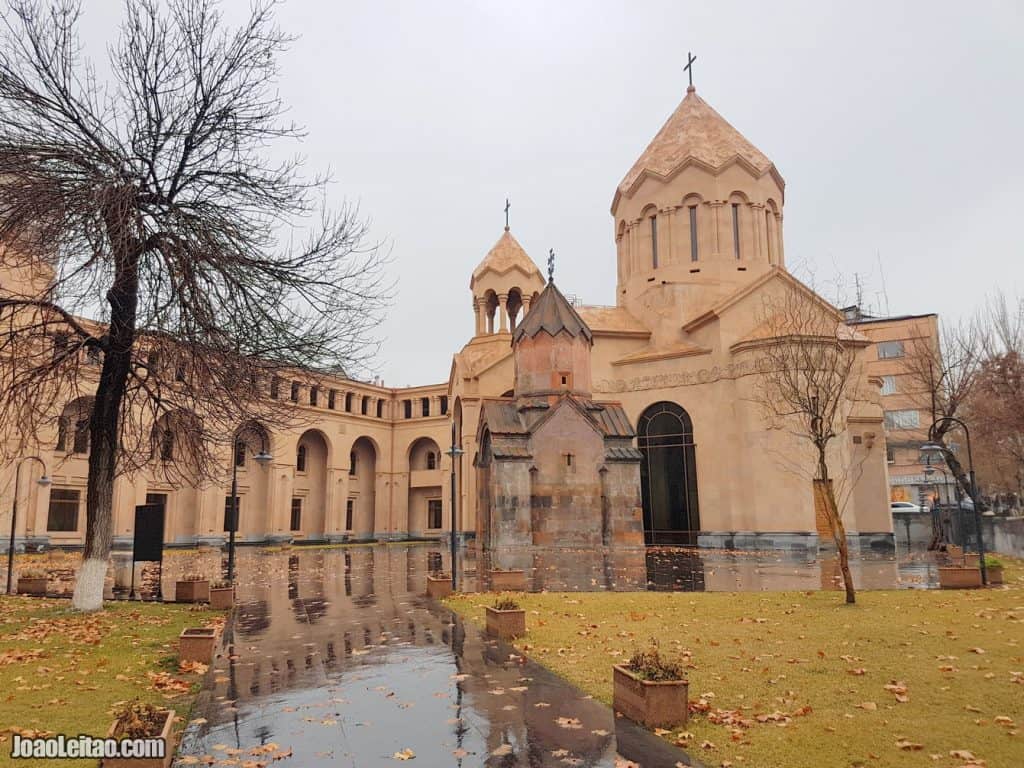
What to visit in Yerevan
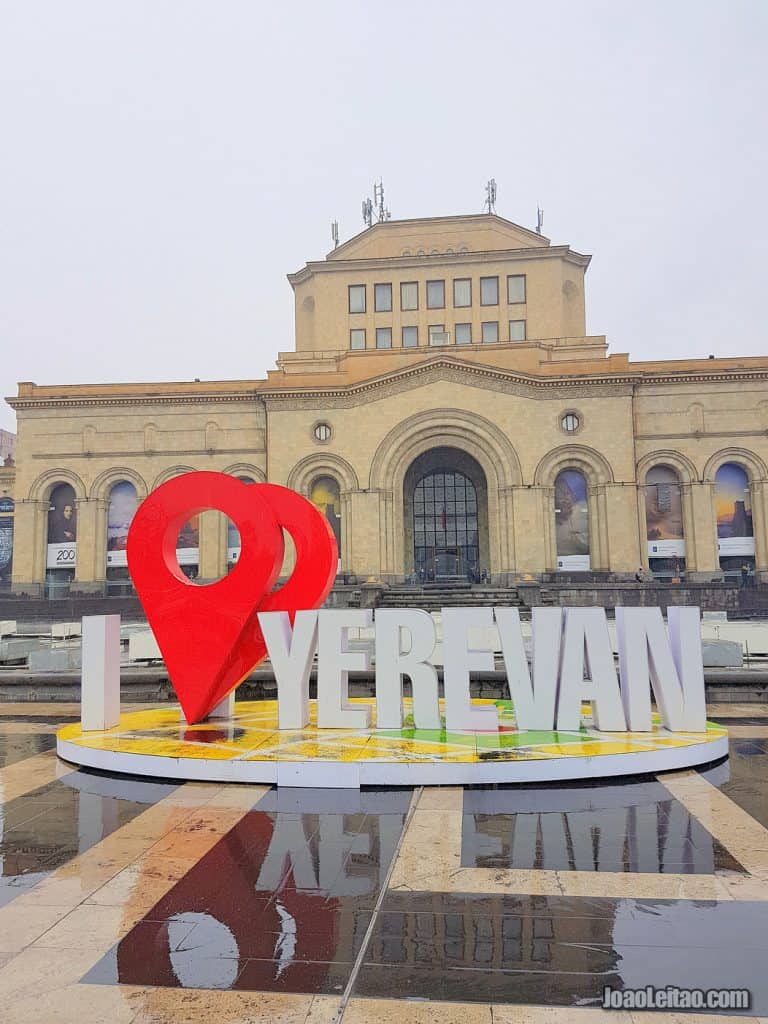
Most famous sites
- Republic Square
- Blue Mosque
- Liberty Square
- Ararat Brandy Museum
- Kentron Stairs
- National Gallery of Armenia
- Genocide Memorial Museum
- Vernissage’s Old Market
- Mother Armenia
- Military Museum
- Fortress of Erebuni
- Opera and Theater
- Victoria Park
- Matenadaran
- Yerevan History Museum
- Avehak Isahakian House
- Cafesjian Art Center
- Katoghike Church
Map of Attractions
Tours in Yerevan
Yerevan City Guide
Republic Square

The locals call it Hraparak. It is located in the district of Kentron, right in the center of Yerevan. It is a spacious square that took almost fifty years to build. Its construction advanced especially in the ’50s of the last century, following a megalomaniac project created by the architect Alexander Tamanyan around 1920.
It is the ideal place to spend some time watching the architecture and people passing. In Republic Square, you will find buildings such as the famous Armenia Marriot Hotel, the Armenian History Museum, the Ministry of Communications and the Government Headquarters, which are part of the structures that emerged in the first phase and which are defined as Neo-Classics influenced by the traditional Armenian style.
The National Gallery of Armenia and the Ministry of Foreign Affairs, built later, are modernist buildings.
One of the most exciting features of the square is its musical fountains, which between spring and autumn offer a remarkable show, with water fountains of variable configuration, very well lit and whose effects evolve to the sound of music of varied genres.
Blue Mosque
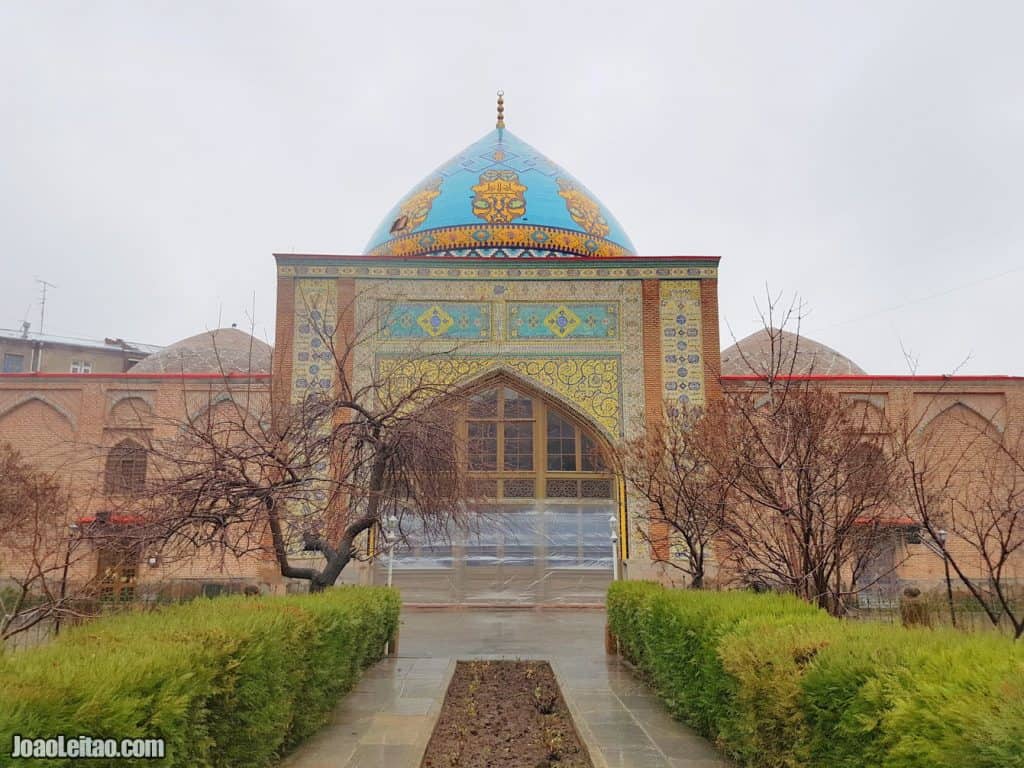
The Blue Mosque, or Kapuyt Mzkit in Armenian, was initially built in 1765 but was closed at the beginning of the 20th century when the Soviet Union was formed following the Revolution of 1917. By 1931 all religious services were suspended, and the mosque was used to house the Museum of the City of Yerevan.
After Armenia’s independence in 1991, the mosque was almost entirely rebuilt, with Iranian funding, and is currently the only Muslim temple active throughout the country.
It is clearly more beautiful on the outside, with the walls decorated by beautiful mosaics, while the interior is austere. It has a colorful dome, a minaret and is surrounded by well-kept gardens where there are some fountains. There is an interior courtyard, and there are a library and a theological school.
The mosque is in the center, more specifically on Mashtots Avenue, and can be visited between 10:00 and 13:00 and 15:00 and 18:00.
Liberty Square
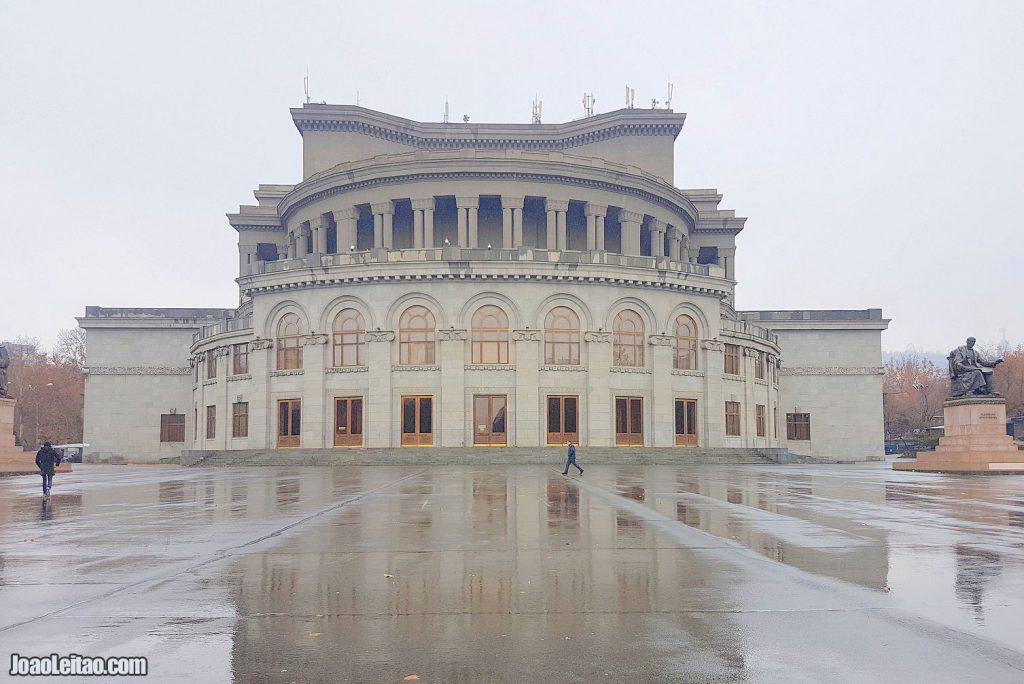
Having been called Opera Square and Theater until 1991, since these buildings are dominant in that area, Liberty Square is located in the central part of the city, in the district of Kentron. It is one of the most important squares of the Armenian capital and considered a symbol of democracy due to the important political demonstrations held here in the past.
Liberty Square ample space can receive between 40 and 50 thousand people. There is a large underground car park with a capacity of 500 cars. It was built in the summer of 2008, and some say that the project was designed to avoid the use of space for anti-government demonstrations at a critical time when a large part of the population contested the legitimacy of the election results that took place that year.
In the square, you can notice the statues of the writer Hovhannes Tumanyan and the composer Alexander Spendiaryan.
Yerevan Cascade (Kentron Stairs)

The broad staircase connecting the Kentron area to the hilltop area of the monuments of Yerevan is one of the most iconic sites in the Armenian capital. It was initially built in 1971, in the era of the Soviet Union, and entirely renovated already in the period of independent Armenia in 2009.
The complex is actually composed of two staircases, which line an architectural complex that functions as a waterfall. There are eight levels of stairs, but anyone who is not up to the challenge can use the existing elevator.
The Yerevan Cascade is adorned by trimmed gardens and diverse statuary, while the Cafesjian Cente for the Arts is embedded in the staircase.
From the top, there is a fabulous view of the city which is especially recommended at the end of the day, when public lighting starts to light up.
National Gallery of Armenia

The National Gallery of Armenia was established in 1921 by the decision of the Government of the Soviet Republic of Armenia. It was located on Astafian Street, in a two-story building that had been a men’s high school.
After changing its name a couple of times, following the country’s independence in 1991, it was renamed the National Gallery of Armenia. This was followed by a reorganization that allowed collections of other State museums to be brought together in the National Gallery, along with groups of medieval and ancient Armenian art and Russian paintings.
These were difficult times, however: the collapse of the Soviet Union broke almost 100-year ties with various institutions of the same type throughout the USSR, and economic difficulties did not allow connections with galleries in other countries.
In 2002 a new director was chosen: Paravon Mirzoyan. Under his guidance, the gallery became an independent, non-profit organization and funds were obtained for a thorough renovation completed in 2004.
The gallery can be visited every day except Mondays, between 11:00 and 17:00, although on Sunday it closes an hour earlier. The ticket costs 1,500 Drams.
History Museum of Armenia
This museum is located in Republic Square, right in the center of the city. It was founded in 1919, and at that time it was renamed Ethno-Anthropological Museum and Library. Throughout its course, it changed name several times, until the current denomination was chosen in 2003.
The History Museum of Armenia was initially established with a group of collections gathered for the purpose, but in 1935 the collected materials were dispersed by smaller museums, created at the time.
It is the state museum, which currently holds more than 400,000 pieces, with particular emphasis on the areas of numismatics and archeology, but with significant collections in of ethnography and documentation.
Individually we can highlight the 782 BC cuneiform inscription of the foundation of the city, at the time called Erebuni, and also the exhibitions of ancient Armenian bronze coins from the third century BC.
The museum is open every day except Mondays, between 11:00 and 18:00 and the ticket costs 2,000 Drams.
The Armenian Genocide Museum-institute
The Armenian Genocide Museum is a complex known as Tsitsernakaberd. It highlights and recalls the so-called “Armenian Genocide,” which the Armenian people were subjected by the Ottoman Empire from April 1915 onwards.
The existing monument in the place appeared in the middle of century XX. The construction began in 1966, following a series of movements by prominent Armenian personalities and street demonstrations that demanded that the Soviet power recognize the existence of genocide.
When it was completed in 1967, the population could see the 44-meter stele that stood there, symbolizing the rebirth of the Armenian people. Twelve blocks arranged in a circle represent the twelve provinces lost to Turkey, and in the center, there is an eternal flame. In the square, there is a wall with a hundred meters with the names of settlements where massacres and deportations existed.
The Museum emerged later, having opened to the public in 1995, that is, the 80th anniversary of the genocide. The building was designed by the architects Sashur Kalashian and Lyudmila Mkrtchyan and by the sculptor F. Araqelyan.
The Museum is open every day except Mondays, from 11:00 am to 5:00 pm and entrance is free.
Ararat Brandy Museum
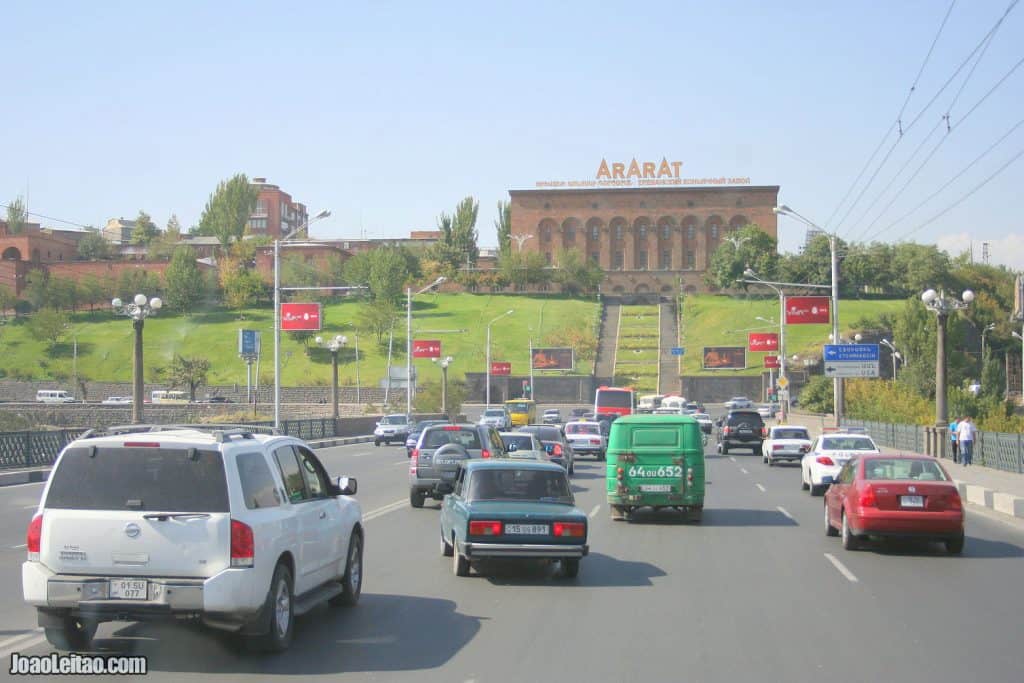
Since this is a Christian country, the production of alcoholic beverages in Armenia has a long tradition, with particular emphasis on the brandy, being Ararat the most reputable brand.
Ararat brandy began to be produced back in 1887. It was Nerses Tairyants merchant that invested in the distillery, then installed in the fortress of Yerevan which he also bought.
In 1889 Nikolai Shustov acquired the business and the following year sent some bottles to Paris, where they had an unexpected success.
In 1913 the company was producing 82,000 bottles of brandy a year, and Nikolai Shustov had been appointed an official supplier to the Russian imperial court.
In 1920, following the Soviet Revolution, the company was nationalized. In 1953 the old premises were no longer sufficient, and the distillery moved to a larger place, changing the name to Yerevan Brandy Company.
Take into consideration that you must schedule the museum visit in advance. If you just show up there, you will not be allowed in.
Yerevan Vernissage open-air market
This market is held every day, from morning to late afternoon, but is clearly more lively at weekends. It extends for the 350 meters that separate the streets Arand and Buzand, in the center of Yerevan. In Vernissage Market you can find pieces of art, tapestry, jewelry, books, numismatics, musical instruments and much more. In short, a box of surprises with a fantastic environment whose visit is recommended especially if you walk through Yerevan at the weekend.
The tradition of this market began in the 1980s, when local artists began to display their works on the street, near the Artists’ Union of Armenia. This is where the name vernissage comes from, a French word describing a preview of an art exhibition.
Mother Armenia Military Museum
The Monument of Mother Armenia occupies a strategic position, having been built on a hilltop near the center of Yerevan. The statue depicting Mother Armenia is made of copper and is set on a huge basalt-inspired bastion in the shape of an orthodox church of three naves, totaling 51 meters in height.
The monument was created in 1961, and designed by architect Rafayel Israyelian and sculptor Ara Harutyunyan. At the base of the statue is the small Military Museum, whose collection is not especially rich, but offers a pleasant visit to anyone who decides to go.
The exhibition is devoted almost exclusively to the armed conflict between Armenia and Azerbaijan, caused by the dispute of control of the territory of Nagorno-Karabakh.
The Museum is open every day except Mondays, from 10:00 am to 5:00 pm. Sundays, from 10:00 to 3:00 pm.
Erebuni Fortress

From the fortress of Erebuni, the historical core of Yerevan, there is little left. It was initially built in the 8th century BC by King Argishti I, who chose the top of a hill rising about 65 meters over the rest of the city.
Archaeological works, which began around 1950, revealed a very sober original plan, which was characteristic of the architecture of the time. The dominant building material was mud bricks, and the segments that survived to this day show us that the tallest walls reached 12 meters.
In the complex, there were religious buildings, a palace, and several residences. Some vestiges prove a rich decoration of the walls, especially in shades of blue, and the abundant use of floral motifs.
Apart from the fortress visit, you can enjoy breathtaking views of the entire Armenian capital. It is usually a quiet and relaxing place, ideal for those looking to get away from the urban bustle.
Yerevan Opera Theatre
The building of the Yerevan Opera Theatre was designed by the architect Alexander Tamanian, who used a revolutionary solution, uniting the two auditoriums in a single block, very uniform and semicircular. One can note the aesthetic influences of medieval Armenian architecture, applied in a stylized way.
The theater segment was completed in 1939 and part of the opera was added in 1963, but what we see today is the result of a total renovation that took place in 1980.
The theater room has a capacity for 1,260 spectators while the opera house can hold 1,400 people, both having an amphitheater layout and endowed with extraordinary acoustic qualities.
Victoria Park
The Victory Park celebrates the victory of the Soviet Union in World War II, having been created in the ’50s of the last century. It is located at the top of the Norksk hill and is very popular with the residents of Yerevan. The monument of Mother Armenia and its small military museum is located in Victoria Park.
The park has all the infrastructures one would expect to find in such a space, with several rails, an artificial lake, garden benches and a series of cafes. There are also amusements such as carousels and other entertainment venues. In addition to all this, the views from here are magnificent, and you can see the entire center of Yerevan.
Matenadaran
In archaic Armenian, matenadaran means “deposit of books.” It functions as the National Archives of Armenia, having as its initial collection the manuscripts that belonged to the Echmiadzin Monastery (Vagharshapat).
The archive, which is also a scientific research center for ancient manuscripts, was opened in 1959 and currently has a collection of more than 17,000 ancient manuscripts and 100,000 documents of historical value. In addition to the Armenian manuscripts, which form the backbone of the property, there are also manuscripts in Russian, Hebrew, Latin, Arabic, Syrian, Greek, Japanese, and Persian.
The earliest documents date from the fifth century, and there is a remarkable collection of printed books from the sixteenth and eighteenth centuries.
The Matenadaran was built on the basis of the architectural traditions of the 12th and 13th centuries and in the surrounding space, you can see a monument dedicated to Mesrop Mashtots, the creator of the Armenian alphabet, accompanied by other great names of the national culture, such as Movses Khorenatsi, Anani Shrakatsi, Mkhitar Gosh, Torinos Roslin, Frik and Gregory Tatecatsi.
The Matenadaran can be partially visited, being open every day except on Mondays, between 10:00 and 17:00.
Yerevan History Museum
The Yerevan History Museum was created in 1931 and called, at the time, Museum of the Community, assuming its current denomination five years later. It initially operated on the second floor of the fire station, and from 1936 it was installed in the blue mosque. Already after the independence of Armenia, it passed through the facilities of two high schools before finding its present residence in the new building of the Town Hall, designed by the architect Jim Torosyan.
It has a collection of 90 thousand pieces, with emphasis on archeology, ethnography, numismatics, arts, photography and documentation sections.
The Yerevan History Museum exposition tells the story of the human presence in Yerevan, with some particular highlights, from six-thousand-year-old artifacts found in Shengavit, to frescoes and cuneiform documents brought from the Erebuni Fortress.
This museum is closed on Sundays and is open on all other days between 11:00 and 17:30. The ticket costs 500 Drams.
House-Museum of Avetik Isahakian
This is one of about ten house-museums existing in Yerevan, worth in part for a sense of antiquity that is not easy to be found in the city. Avetik Isahakian was a poet and writer who left an indelible mark in the Armenian society.
Avetik Isahakian works have long been studied in Armenian schools, and in 1945, the year of his seventieth birthday, the country offered him this residence that became a museum in 1963.
Here the visitor can observe the poet’s private rooms, a significant collection of his belongings, a series of pieces of art that belonged to him and his personal library. It is also a portrait of mid-twentieth-century Yerevan and the daily life of its residents.
The house can be visited every day except on Mondays, between 11:00 and 16:00. The ticket costs 500 Drams, and guided tours in English can be arranged, costing 2,500 Drams.
Cafesjian Museum of Art
Cafesjian Museum of Art was opened in 2009 and is located in Kentron stairs. The center has five different galleries. In the Khanjyan gallery, you can see the murals of the painter Grigor Khanjyan, who died in 2000, that dealt with themes related to the history of Armenia.
Through the Eagle gallery, there are temporary exhibitions with pieces belonging to private individuals. In the Sasuntsi Davit gallery, there’s a collection of more than one hundred pieces of glass by the Czech artists Stanislav Libensky and Jaroslava Brychtova. The Swarowsky gallery displays Swarovski swatch items, created by Vincent Van Duysen, Tord Boontje, Georg Baldele, Michael Anastassiades, Diller Scofido, and Renfro Studio.
The gallery is open from Tuesday to Thursday from 10:00 am to 5:00 pm and from Friday to Sunday from 10:00 am to 8:00 pm, closing on Mondays. Part of the space can be visited for free, but a 1,000 Drams ticket is required to access the remaining galleries.
Katoghike Church

Katoghike Church dates originally from the thirteenth century, but from what we see today there is little left of its original medieval construction. In 1679 a violent earthquake made Yerevan shake, and Katoghike Church was one of the structures that didn’t survive. The present church is, therefore, the result of the reconstruction carried out in the following years.
The church does not have a dome, presenting a characteristic plant of Armenian religious architecture, with three naves. There are two entrances to the south and west.
During the Soviet era, the authorities decided to build housing blocks on the site, and the church was condemned to destruction, but when workers found vestiges of the original building the population and scientific community united and pressured the Government and consequently the church was spared.

